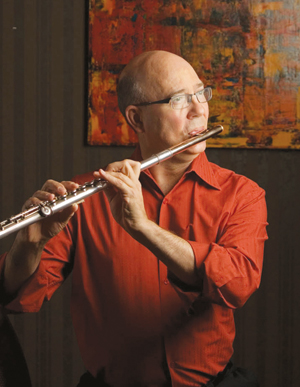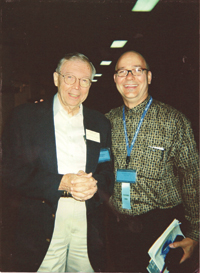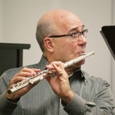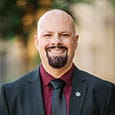.jpg)
For the past 33 years, George Pope has been the professor of flute at the University of Akron and has recently added the flute professorship at Baldwin-Wallace Conservatory near Cleveland to his busy schedule. When students audition for him, the first conversation they have includes the difficulties of a career in music. “I tell them they should balance their dreams with reality. Believe in yourself and work hard, but take advantage of all your skills and interests. Classical music has been struggling in this country for a while. Even large orchestras struggle. With fewer jobs in music you have to find your own niche. Many people have discovered their jazz chops, or have started chamber music groups and are very successful at that. I also tell students that if you want to have a life in music, you can make it happen. It may not be exactly what you planned, but you can create a career in music from the many possibilities beyond the narrow list of standard choices.”
Pope is a demanding teacher encouraging his students to become more discriminating in their listening skills. “It is so easy for students to listen to music today; but often they take the easiest route by watching a video online. When questioned about the performance, they usually don’t know who the performer was. When I was a student, I listened to records all the time. Someone could drop the needle on a record, and I would immediately have an informed idea of who the player was or what orchestra was playing. I listened to everything and still do, including violinists, classically-trained and popular singers, pianists and so forth. I want to sound like them all.”
Pope requires his students to keep a notebook for their flute studies. The notebook includes handouts received during the term, summaries of lessons (minimum of ten), written comments the flutist has received about his performances from fellow students, repertoire lists, a personal project which changes from semester to semester (research, with a written document), and a practice diary in which the flutist sets and records daily, weekly, monthly and semester goals. The student’s goal may be as simple as “Today, I will remember to lift my left index finger on the middle octave D and E flat,” or a more comprehensive goal such as “memorizing all the major scales by next week, and the harmonic minor the following week and so forth.
 “A student may also plan a series of performances that could lead to a larger project such as a recital, audition or recording session. These plans might include securing performance dates and locations, and if necessary, coordinating the publicity for the events. I have been very impressed by the progress my students make when they organize their work and practice with specific goals every day. After completing the practice diary for just one term, many have said “now I love to practice as much as to perform.” Pope checks the diary weekly and at the end of the term.
“A student may also plan a series of performances that could lead to a larger project such as a recital, audition or recording session. These plans might include securing performance dates and locations, and if necessary, coordinating the publicity for the events. I have been very impressed by the progress my students make when they organize their work and practice with specific goals every day. After completing the practice diary for just one term, many have said “now I love to practice as much as to perform.” Pope checks the diary weekly and at the end of the term.
At the end of each term, the student extracts a Top Ten List of things he has learned during the semester. Pope and the student discuss the list and evaluate whether short and long term goals have been met. Together they set new goals for the next term. Pope then grades the notebook on completeness and the quality of the work. This process helps the student focus on his flute studies and gain the most out of his efforts. In the future when the student has his own students, the lesson notebook serves as a valuable teaching resource.
“I make every effort to assign my undergraduate students a balanced diet of tone and technical studies, etudes, solo repertoire from all periods and in all styles, and chamber music. It is essential that they have as broad a musical experience as possible. Each term the student is assigned at least three works selected from the solo, sonata, concerto or show piece genres. The compositions are also chosen from different style periods and vary in length. One of the pieces will be performed early in the term, another later in the term, and the most difficult sometime in the future. Graduate students get the full treatment in half the time. Regularly we review the flutist’s repertoire list to ensure he has covered the major flute repertoire and explored as much new repertoire as possible.” (click here to download Pope’s syllabus pdf)
Practical Experience
“Many years ago my students and I started the Northeastern Ohio Flute Association, a registered student organization at the University of Akron. The NEOFA sponsors and organizes an annual Flute Festival for which we bring in guest artists from around the world. Not only do my students experience the artistry and inspiration of our guests, but they learn to organize, fund and run a festival.
“The most challenging aspect of running an organization or a festival is learning to deal with bureaucracy. Last year we submitted four different sets of paperwork to the university requesting funding for one guest artist’s appearance. That is both frustrating and educational.
“The students develop professionalism by working with the music industry community through the solicitation of corporate sponsorships and organizing exhibits for the annual flute fair. Students also gain sales experience by selling coffee and chocolates. This work takes time and patience.
“On the flute festival day, the students are organized into several committees. One committee sets up the exhibit area and the stage. This entails moving chairs, tables, pianos, and music stands as needed. Another committee handles the financial affairs of the day and writes a final report of the event, while another committee is in charge of the program, food and hospitality. After students have participated in NEOFA for several years, they have the confidence and knowledge to organize events themselves.”
First Music Experiences
Pope’s musical aspirations began after he watched a television broadcast of Julius Baker performing in one of the legendary New York Philharmonic Young People’s Concerts. Pope knew he wanted to play the flute and began his training in a public school music program. He grew up in Dewey, Oklahoma, population 2500 where he had previously studied piano with his mother and sung in local church and community choirs. Through his parents’ influence he was no stranger to classical music, and the first record he bought at the age of 10 was of Stravinsky’s Firebird, The Complete Ballet. He played in All-State orchestras and bands in high school, and in the fall of his senior year was invited to join the Tulsa Youth Symphony and began his first private flute lessons with Marion McNally, principal flutist of the Tulsa Philharmonic. McNally had actually studied with Julius Baker while she was a student at Oberlin.
Pope relates, “McNally had me play long tones while standing in front of a large mirror. She taught me to examine my embouchure and discover what I needed to do to sustain the focus in my sound. We discussed the size and shape of the aperture and how it functioned at various dynamic levels and to control intonation. As I left my lesson each week, she handed me a stack of music to sightread during the next week. Of course this music was in addition to the material I was to prepare for my next lesson. Years later when I was programming recitals, I would realize I knew so many compositions thanks to McNally’s lending library.”
Arts Exploration
“During my senior year in high school, I wanted to do everything. The local community theater put on a production of the Broadway musical Oklahoma. While most flutists my age would want to play in the pit for the production, I wanted to be on stage. I auditioned and was placed in the chorus and also given a role as a dancer. This experience rekindled my fascination with both classical and modern dance. Later when I entered the University of Tulsa as a Music Education major, I sang and danced in a production of Gian Carlo Menotti’s Amahl and the Night Visitors. From 1976 to 1978, when I lived in New Mexico, I studied ballet and modern dance seriously. In my flute teaching, I have developed exercises based on the concepts I learned from this instruction. For example, both dancers and flutists should learn to center the body to achieve balance. I often have my students plié (bending the knees), relévé (up on the toes), and stand on one leg while playing to discover the secrets of good balance. We should learn to express our internal rhythm and explore the meaning of the musical gestures. Once in sync with the music, we learn to breathe in the most efficient and successful way.
“When I am learning new music or relearning something for a concert or recital, I often choreograph the music phrase by phrase. Once I find the proper physical gesture, the musical phrases come alive for me. In fact, every note I play is choreographed in my head.”
Further Studies
After graduation from the University of Tulsa, Pope studied privately for two years with Maurice Sharp, who for 50 years was principal flute of the Cleveland Orchestra. “Sharp immediately put me on a technical diet, covering important essentials. I felt as if he was cleaning all the rust out of my brain. I still use and teach some of his original exercises.”

In 1974 Pope became Walfrid Kujala’s first graduate assistant at Northwestern University. “It was an eye-opening experience due to the quality of the school and the level of professionalism that existed there. My main responsibility was to organize Kujala’s teaching schedule. He was a very busy man. Not only was he playing piccolo in the Chicago Symphony and teaching 25 students at Northwestern, but for that year he had assumed half of the flute professorship at the Eastman School of Music, his alma mater. “Kujala was completely committed to the instruction of his students. He set up a reel-to-reel tape recorder in his studio and asked every student to record an hour-long practice session each week using the state-of-the-art equipment. So, for each of the 25 students, I not only scheduled a lesson time, but also a recording practice session. I also taught the flute methods class, attended all the flutists’ dress rehearsals, and started the first flute choir at Northwestern.
“In my lessons Kujala shared very clear musical and technical ideas for me to experiment with and explore. For example, he suggested I try the Rockstro position for holding the flute. After a week, I found it uncomfortable so he said fine, and we went on to something else. He talked about playing with confidence, and when I expressed any negative attitude, he would instruct: ‘don’t go in that direction.’ He was wonderful at analyzing all aspects of my playing, and I felt that he treated me more like a young professional than as a student. He is truly one of the great pedagogues and kindest gentlemen of our time.”
Pope continued private studies in Florida with Geoffrey Gilbert, London Symphony Orchestra principal flute and well-known pedagogue; and British flutist and soloist William Bennett. “I believe I had the best of both worlds with these teachers. Gilbert would say, ‘This is how you do it. Now make music.’ Wibb (William Bennett) would say, ‘This is what the music means. Now let’s figure out how to do it.’ Coming at the musical product from both directions helped me to be more flexible and creative.”
Pope continued, “I have always been impressed with Gilbert’s approach and attitude about playing the flute. This was a man, who in mid-career, decided to undertake a major overhaul of his embouchure. He became the first English flutist to embrace the French style and continued to have a brilliant career as an artist and an inspired teacher.”
Orchestra and Chamber Performance
.jpg) Pope won his first professional orchestral job at the age of 19, playing second flute in the Tulsa Philharmonic during his years at the University of Tulsa. When he began teaching at the University of Akron in 1978, the job also included playing principal flute in the Akron Symphony, a position he held for 24 years. He also has played with the New Mexico Symphony Orchestra, was co-principal of the Canton, Ohio Symphony and performed with the Cleveland Orchestra, the Toledo Symphony, Lyric Opera of Cleveland, the Brevard Music Center Orchestra, and is currently principal flute of the Blossom Festival Orchestra.
Pope won his first professional orchestral job at the age of 19, playing second flute in the Tulsa Philharmonic during his years at the University of Tulsa. When he began teaching at the University of Akron in 1978, the job also included playing principal flute in the Akron Symphony, a position he held for 24 years. He also has played with the New Mexico Symphony Orchestra, was co-principal of the Canton, Ohio Symphony and performed with the Cleveland Orchestra, the Toledo Symphony, Lyric Opera of Cleveland, the Brevard Music Center Orchestra, and is currently principal flute of the Blossom Festival Orchestra.
Pope has always enjoyed playing chamber music as well. He performs with the Solaris Woodwind Quintet, the faculty quintet at the University of Akron. The group has previously recorded two CDs of American Quintets featuring the works of Northeastern Ohio composers Dan McCarthy, Nikola Resanovic, Jack Gallagher and Roger Zahab as well as some well-known American icons like Samuel Barber, Henry Cowell, Scott Joplin and Stephen Foster. Solaris will soon release their third CD, a collection of 16 newly arranged Scott Joplin Rags. (www3.uakron.edu/solaris)
Pope says he has performed chamber music with most of his university colleagues at one time or another. He played in a flute, cello, and harp trio for six years and started a chamber series in Akron that is now in its 15th year. He also in his fourth season performing at the Swannanoa Chamber Music Festival that plays concerts in and around Asheville, North Carolina during the summer.
Future Projects
“My first goal is to finish a project I started too many years ago; a collection of Maurice Sharp’s technical exercises that I have collaborated on with many of his former students, primarily with my friend Susan Waller. I want to continue to practice and play my best. I want to record a solo CD which I have not had the time to do so far. I want to serve as a good example to my students and help them find their own musical way. I also have a huge stack of music that I want to arrange for woodwind quintet, flute choir or flute and piano. My partner Todd and I will celebrate 25 years together in 2012 and that will be quite a party. The bottom line is I want to maintain a healthy, happy balance in life.”
(click here to download Pope’s syllabus pdf)





